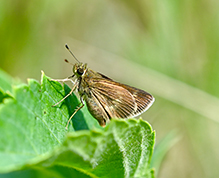northern broken-dash
(Polites egeremet)
Conservation • Description • Habitat • Ecology • Distribution • Taxonomy
|
|
||||||||||||||
Description |
Northern broken-dash is a small, dark, nondescript, grass skipper. It occurs in the United States and southern Canada east of the Rocky Mountains. It is most common in the northeast from Maine to Michigan south to Massachusetts and Ohio. It is uncommon but sometimes locally abundant throughout its range, including in Minnesota. Adults are found from late June to mid-August in open places near wooded or shrubby areas, including fields, pastures, meadows, woodland edges, gardens, and roadsides. They drink nectar from white, pink, and purple flowers, including alfalfa, red clover, dogbane, New Jersey tea, milkweed, and blazing star. Larva feed on the leaves of panic grasses (Panicum spp.). Adults have a 1″ to 1 9⁄16″ (25 to 39 mm) wingspan. The upper side of both wings is dark brown with orange or light yellowish-brown (pale) markings and a brownish fringe. On the male the leading edge (costal margin) of the forewing is pale. The group of specialized scent scales (stigma) on the male forewing is black and is interrupted in the middle, like a “broken dash”. This is the feature that gives the species its common name. The black stigma is difficult to see against the dark brown background. There is a pale flag-like spot at the end of the stigma. Females do not have a stigma, but have the pale flag-like spot in the same place as the male. As with many skippers, there is a row of three small pale spots, the “wrist bracelet”, on the forewing near the costal margin in the subapical area. The underside of the hindwing is yellowish-brown and often has a violet sheen. There is a faint, pale, postmedian band in the shape of a backwards 3. The antennae are short and barred. Each antenna has a swelling (club) at the tip, and a pale, thin, hooked extension (apiculus) at the end of the club. The club is black above and orange below. There is not a white band below the club. Early stage (instar) caterpillars have a yellow body and a black head. After overwintering, late instar caterpillars are light green and tan with dark green mottling, a dark central stripe, and a tannish band on each abdominal segment. Mature caterpillars are active in the spring. |
Size |
Wingspan: 1″ to 1 9⁄16″ (25 to 39 mm) |
Similar Species |
Northern broken-dash, Dun skipper, and little glassywing are called “the three witches” because their dark wings make it difficult to tell “which one is which.” Dun skipper (Euphyes vestris) has a darker brown background color. On the hindwing, the postmedian band is narrower and the spots are smaller. The male has no pale spots on the forewing and no row of faint spots on the hindwing below. Little glassywing (Vernia verna) has a darker brown background color. On the hindwing, the postmedian band is narrower and the spots are smaller. There is a white band just below the antennal club. |
Habitat |
Open places near wooded or shrubby areas, including fields, pastures, meadows, woodland edges, gardens, and roadsides. |
Ecology |
Season |
One generation per year: Late June to mid-August |
Behavior |
Males perch on vegetation up to 6′ above the ground, usually in early morning, waiting for passing females. |
Life Cycle |
Middle instar caterpillars overwinter. |
Larva Hosts |
Leaves of panic grasses (Panicum spp.). |
Adult Food |
Nectar from white, pink, and purple flowers, including alfalfa, red clover, dogbane, New Jersey tea, milkweed, and blazing star. |
Distribution |
||
|
Sources 21, 24, 27, 29, 30, 71, 75, 82, 83. Biodiversity occurrence data published by: Minnesota Biodiversity Atlas (accessed through the Minnesota Biodiversity Atlas Portal, bellatlas.umn.edu, 7/6/2025). |
|
| 7/6/2025 | ||
Occurrence |
||
Uncommon but sometimes locally abundant in Minnesota |
||
Taxonomy |
|
Order |
|
Superfamily |
Papilionoidea (Butterflies) |
Family |
Hesperiidae (Skippers) |
Subfamily |
Hesperiinae (Grass Skippers) |
Tribe |
Hesperiini |
Suntribe |
Hesperiina (Branded Grass Skippers) |
Genus |
Polites |
Subgenus |
Wallengrenia (broken-dashes) |
Superfamily Genus |
|
Subordinate Taxa |
|
|
|
Synonyms |
|
Hesperia cinna Pamphila ursa Wallengrenia egeremet |
|
Common Names |
|
northern broken-dash |
|
Glossary
Apiculus
A thin hooked or pointed extension at the ends of each antenna just beyond the club of all skippers except skipperlings (subfamily Heteropterinae).
Costal margin
The leading edge of the forewing of insects.
Instar
The developmental stage of arthropods between each molt; in insects, the developmental stage of the larvae or nymph.
Stigma
In plants, the portion of the female part of the flower that is receptive to pollen. In Lepidoptera, an area of specialized scent scales on the forewing of some skippers, hairstreaks, and moths. In other insects, a thickened, dark, or opaque cell on the leading edge of the wing.
Visitor Photos |
||
Share your photo of this insect. |
||
This button not working for you? |
||
Scott Leddy |
 |
MinnesotaSeasons.com Photos |
||
|
||
|
||

Visitor Videos |
||
Share your video of this insect. |
||
This button not working for you? |
||
|
Other Videos |
||
Northern Broken Dash Love |
About
Sep 22, 2014 Northern Broken Dash Skippers Male & Female 09 01 14 |

Created: 5/5/2021 Last Updated: © MinnesotaSeasons.com. All rights reserved. |




